Setting the Bridal Table - 1916
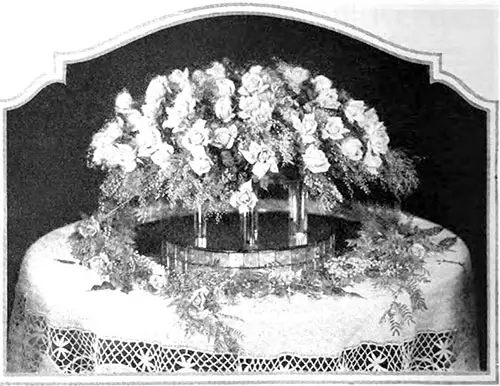
Simplicity is the key-note of wedding decorations: hence this Centerpiece of roses and lilies of-the-valley, spreading above slim crystal vases like a veritable bride’s bouquet. As to the tablecloth, that may be as elaborate as you please—of exquisite linen, cobwebby with lace.
As to the trend of thought toward the simple or the grandiose, few signs are more reliable than those of wedding ceremonies.
In sumptuous ages like that of Louis IV, wedding pageants were the very acme of that sumptuousness, and in periods characterized by simplicity, nothing has exceeded the simplicity of the marriage rites. But times have changed, and changed again, since then.
The latest change is from the almost severe stateliness of the stiff white satin weddings of our grandmothers' day to the less imposing weddings of today. Indeed, the wedding of today is often held in the country with outdoor dancing and is almost never as set and formal as twenty years ago.
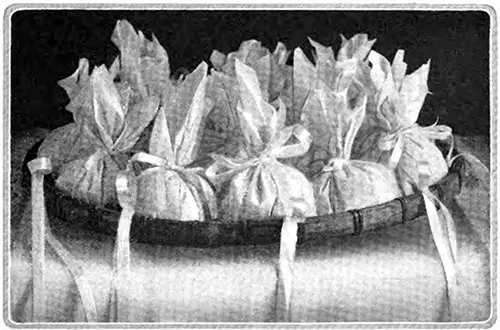
To make prettier still, the pretty sentiment of throwing confetti instead of old shoes after the bride and groom, beribboned packages of confetti may he surreptitiously distributed to the guests.
With this less formal atmosphere, charmingly simple decorations and souvenirs, with a value gauged by the sentiment of the occasion rather than by expensiveness, have come to supplant the rather magnificent affairs of recent years.
A pretty table decoration which is entirely in the same spirit of charm as the new wedding itself is a little fernery affair which may be used on a large table and on smaller tables too. The base of this centerpiece is a fern dish of bright hammered silver with a deep rolling brim.
Instead of the usual gold wire net rounded over the top to hold the flowers up, this bowl has a gold cut-work of flowers and long slim leaves to support the stems of the ferns. Similar bowls of hammered silver have a glass cylinder cut in round tubes to hold flowers upright, in the Japanese fashion.
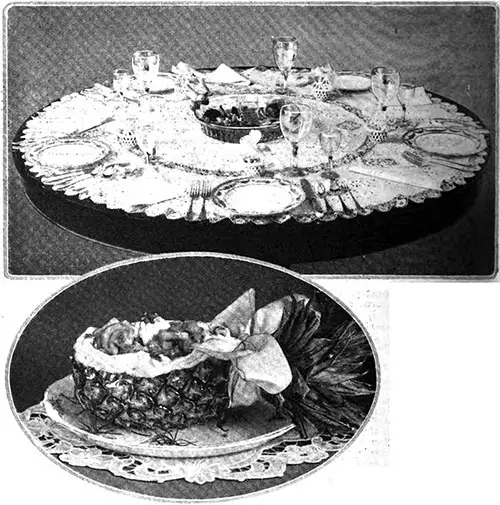
Bridal Table Setting and Salad Served in a Carved-Out Pineapple
The cloth should just tip the table-edge, silver should be laid to use from right to left, the napkin should be folded with the point toward the plate, and the glasses should be placed as shown above. No less refreshing to the eye than to the taste is a salad served from a pineapple: the big bow gives a most excellent opportunity for the clever "color-schemer" to use her artistry.
Another attractive centerpiece is a large silver basket on a standard, with four smaller baskets, one pendant from a branch at each corner of the standard. Such a handsome centerpiece is a delightful gift for the bride’s attendants to unite in giving her.
For the wedding, all the baskets would be filled with flowers, but for a smaller affair the central basket could be removed from the standard, filled with fruit, and used alone as a centerpiece, while the four small baskets filled with flowers could be used at the corners of the table.
A unique idea in wedding decorations is to use silver candlesticks—unshaded as in our grandmothers' day—with the bride‘s monogram engraved on them. These candlesticks are given to the bride's attendants as souvenirs.
Other trifles of decoration which are small in themselves yet add just the right note of charm are the little new table decorations of spun sugar, which are quite the smartest things of the day. They resemble Venetian glass in their fairy-like texture.
For instance, bonbon dishes of spun sugar are made in the form of lovely little baskets with a wreath of flowers on one side and a big disproportionate bow of pink ribbon on the other.
Ice-cream cups of spun sugar are made in the shape of flowers; a morning-glory ice-cream cup of spun sugar is almost as delicate as the flower itself. Also, spun sugar rose petals or sweet peas scattered over a dish of nuts or bonbons are particularly delicate and charming.
Where the distance is not too great, the caterer sends a man specially to arrange the ice cups and other decorative things of spun sugar.
As to the wedding table service, there are few things more attractive than rock crystal. It is now used in many forms, besides the mere glasses and finger-bowls of yesterday.
Both plates and serving dishes may be had now in rock crystal, and for serving a cold menu, there could scarcely be a better choice. With, such a service the gold dishes, which often appear now, add a particularly mellow and lovely touch.
The newest and smartest thing in the way of silver service is the dull finished hammered silver, with a border in a simple chased design.
As a foundation for all these bits of decoration, the table-cloth itself, which lays the foundation of delicacy and taste for all the rest, should be as elaborate as you please.
In a large table the glazed surface of even the most beautiful damask may appear harsh under artificial light, and where a rather plain cloth is used its surface should be broken by lace pieces, an oval piece in the middle, perhaps, with long runners toward each end, and smaller round pieces of lace in between.
There are specially woven tablecloths with large filet medallions of Cupids and garlands joined together by Cluny, which also borders such a cloth.
Sometimes Italian cut-work is used to form a design around the insertions of filet, and there is a border of hemstitching set next to the Cluny border.
A charming custom is for the mother of the bride to present her with the cloth used on the bridal table, to be used afterward at anniversary celebrations.
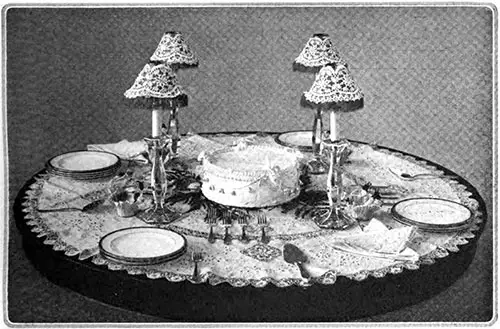
Beside the wedding cake is placed a large silver knife with which the bride serves the cake, and which is supposed to appear again at each anniversary celebration. A pretty custom is for the mother of the bride to present her with the cloth from the bridal table.
And this leads to the subject of the wedding cake, which is conveniently constructed so half of it may be kept for cutting on anniversaries. The lower part of the cake, two inches thick, is separated from the upper part by silver-leaf, but the frosting conceals the joining.
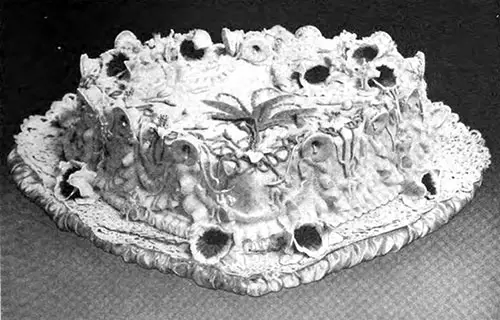
The bride cuts through the cake only to the silver-leaf, and after the wedding, the lower section is carefully wrapped in layers of silver-leaf and her medically sealed. In this way, the cake is preserved for the first, or the twenty-first, or the fiftieth, anniversary.
Often when the white lady cake is used for a bride’s cake, there is a second wedding cake, a black one called the groom’s cake, handsomely iced and decorated. In this, the bride makes one incision, and then it is sealed away in a special box provided for it, not to be opened until the fifth or perhaps the tenth anniversary.
There is always much excitement in finding the ring and other tokens in the bride's cake, and charming little sets in gold and silver may be purchased and baked in the cake.
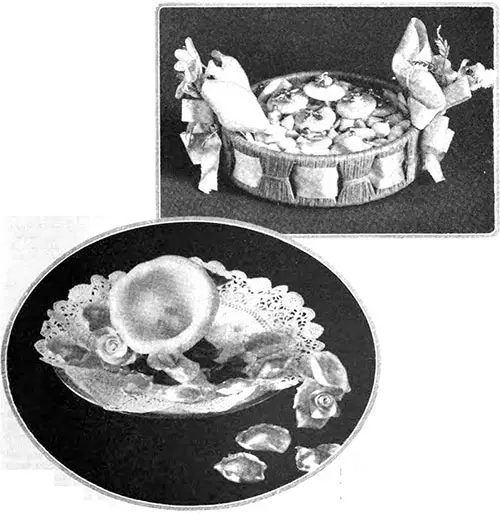
Candy Basket and Spun-Sugar Ice Cream Cup
It is well to put the three feminine tokens—the tiny ring, the thimble, and the lucky coin—in one side of the cake, and the masculine tokens in the other half. The cake is then marked so the bride may know from which side to serve the waiting guests.
A very handsome silver knife engraved with the bride’s name is placed at the right of the cake for serving it. This knife is supposed to appear at each anniversary. If the groom is a military man, however, the cake is cut with his sword.
Charming boxes for the wedding cake may be had in the form of pink satin hearts, and there are less expensive ones in triangles and diamonds with the initials of the bride, or a joining of the initials of the bride and bridegroom, on the top. There are also little oblong boxes tied with narrow white satin ribbon and painted with sprays of the flowers selected for the wedding.
Quite the newest idea, however, is the use of tiny bags, made from the same material as the wedding gown, each of which contains a small cube of the cake wrapped in silver foil. Sometimes small round pieces of the black wedding cake, with icing in the bridal colors, are given to the guests in frilled paper cups.
Gabrielle Rosiere, "Setting the Bridal Table," in Good Housekeeping Magazine, Vol. LXII, No. 5, May 1916, p. 676-677, 680-681.
